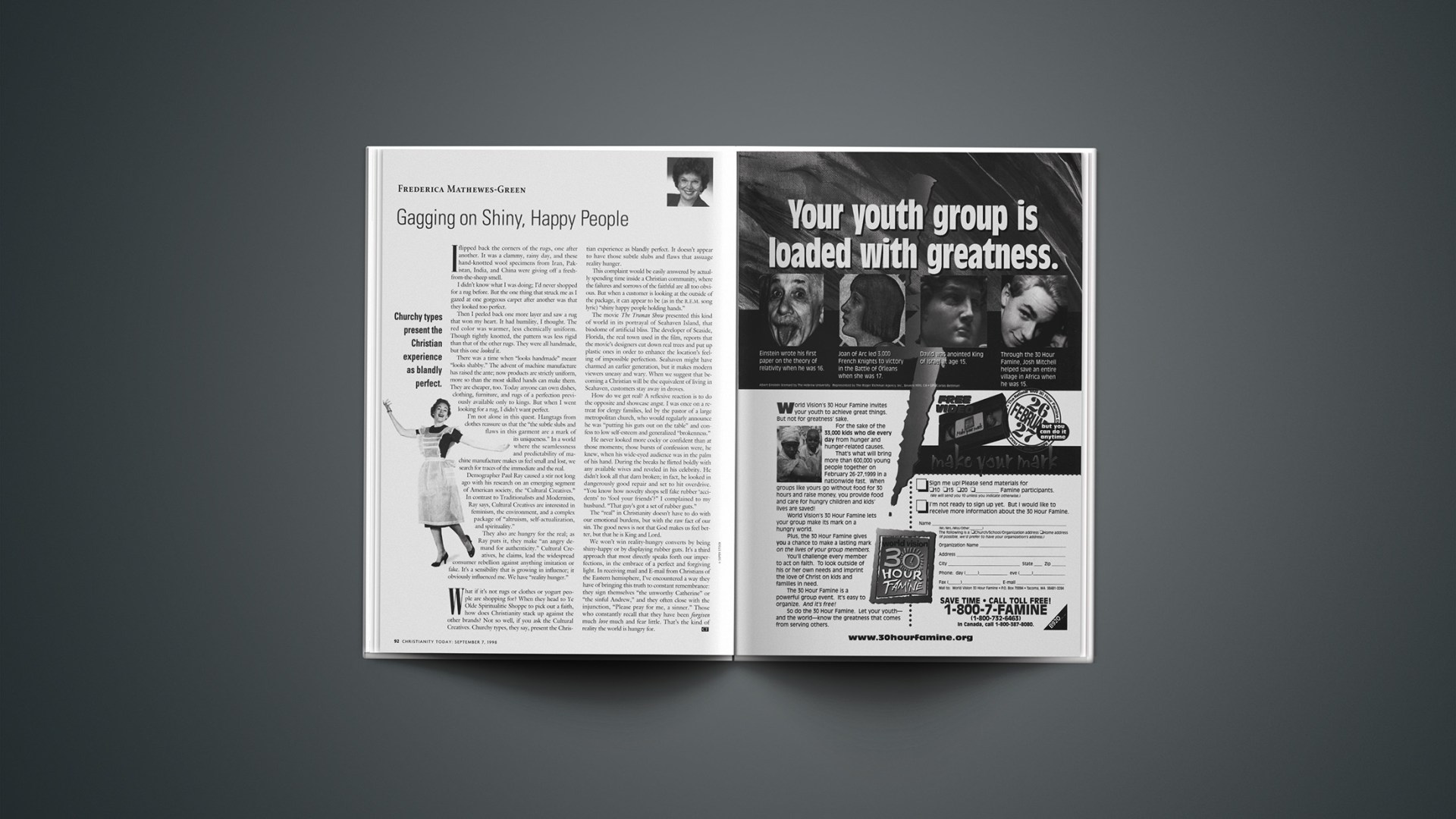I flipped back the corners of the rugs, one after another. It was a clammy, rainy day, and these hand-knotted wool specimens from Iran, Pakistan, India, and China were giving off a fresh-from-the-sheep smell.
I didn’t know what I was doing; I’d never shopped for a rug before. But the one thing that struck me as I gazed at one gorgeous carpet after another was that they looked too perfect.
Then I peeled back one more layer and saw a rug that won my heart. It had humility, I thought. The red color was warmer, less chemically uniform. Though tightly knotted, the pattern was less rigid than that of the other rugs. They were all handmade, but this one looked it.
There was a time when “looks handmade” meant “looks shabby.” The advent of machine manufacture has raised the ante; now products are strictly uniform, more so than the most skilled hands can make them. They are cheaper, too. Today anyone can own dishes, clothing, furniture, and rugs of a perfection previously available only to kings. But when I went looking for a rug, I didn’t want perfect.
I’m not alone in this quest. Hangtags from clothes reassure us that the “the subtle slubs and flaws in this garment are a mark of its uniqueness.” In a world where the seamlessness and predictability of machine manufacture makes us feel small and lost, we search for traces of the immediate and the real.
Demographer Paul Ray caused a stir not long ago with his research on an emerging segment of American society, the “Cultural Creatives.” In contrast to Traditionalists and Modernists, Ray says, Cultural Creatives are interested in feminism, the environment, and a complex package of “altruism, self-actualization, and spirituality.”
They also are hungry for the real; as Ray puts it, they make “an angry demand for authenticity.” Cultural Creatives, he claims, lead the widespread consumer rebellion against anything imitation or fake. It’s a sensibility that is growing in influence; it obviously influenced me. We have “reality hunger.”
What if it’s not rugs or clothes or yogurt people are shopping for? When they head to Ye Olde Spiritualitie Shoppe to pick out a faith, how does Christianity stack up against the other brands? Not so well, if you ask the Cultural Creatives. Churchy types, they say, present the Christian experience as blandly perfect. It doesn’t appear to have those subtle slubs and flaws that assuage reality hunger.
This complaint would be easily answered by actually spending time inside a Christian community, where the failures and sorrows of the faithful are all too obvious. But when a customer is looking at the outside of the package, it can appear to be (as in the R.E.M. song lyric) “shiny happy people holding hands.”
The movie The Truman Show presented this kind of world in its portrayal of Seahaven Island, that biodome of artificial bliss. The developer of Seaside, Florida, the real town used in the film, reports that the movie’s designers cut down real trees and put up plastic ones in order to enhance the location’s feeling of impossible perfection. Seahaven might have charmed an earlier generation, but it makes modern viewers uneasy and wary. When we suggest that becoming a Christian will be the equivalent of living in Seahaven, customers stay away in droves.
How do we get real? A reflexive reaction is to do the opposite and showcase angst. I was once on a retreat for clergy families, led by the pastor of a large metropolitan church, who would regularly announce he was “putting his guts out on the table” and confess to low self-esteem and generalized “brokenness.”
He never looked more cocky or confident than at those moments; those bursts of confession were, he knew, when his wide-eyed audience was in the palm of his hand. During the breaks he flirted boldly with any available wives and reveled in his celebrity. He didn’t look all that darn broken; in fact, he looked in dangerously good repair and set to hit overdrive. “You know how novelty shops sell fake rubber ‘accidents’ to ‘fool your friends’?” I complained to my husband. “That guy’s got a set of rubber guts.”
The “real” in Christianity doesn’t have to do with our emotional burdens, but with the raw fact of our sin. The good news is not that God makes us feel better, but that he is King and Lord.
We won’t win reality-hungry converts by being shiny-happy or by displaying rubber guts. It’s a third approach that most directly speaks forth our imperfections, in the embrace of a perfect and forgiving light. In receiving mail and E-mail from Christians of the Eastern hemisphere, I’ve encountered a way they have of bringing this truth to constant remembrance: they sign themselves “the unworthy Catherine” or “the sinful Andrew,” and they often close with the injunction, “Please pray for me, a sinner.” Those who constantly recall that they have been forgiven much love much and fear little. That’s the kind of reality the world is hungry for.
Copyright © 1998 Christianity Today. Click for reprint information.










